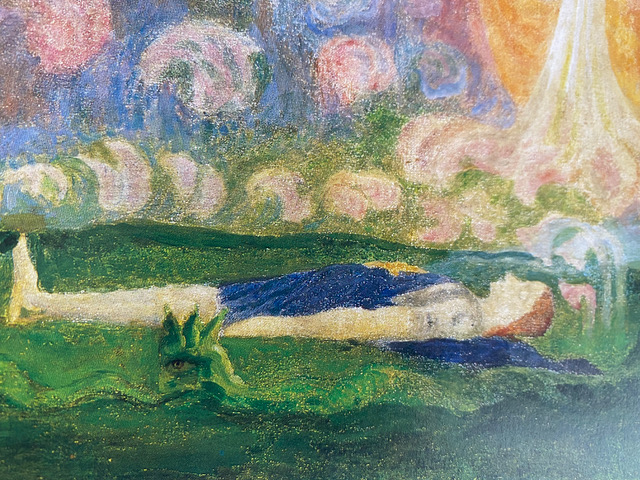Here is a summary of the recent Section for Literary Arts & Humanities meeting of the local group in Fair Oaks, CA. This meeting occurred on March 13, 2021 via Zoom.
“At a Glance . . .”
- The Green Snake and the Beautiful Lily. Once again, we spent the entire evening on this text. We listened to selections from a brand-new translation, complete but still in revision. We arrived at that place in the narrative where the Youth collapses at Lily’s feet — and Lily, stock still, beholds with horror that Youth’s spirit has departed. The Snake, however, has a plan! Will Youth recover? Will Youth rejoin our good company of pilgrims to the bridge? A cliff hanger!
- Performances! Our work this year with Goethe’s Fairy Tale has gone forth into the community! As it should! Karen has organized a reader’s theater that meets outdoors at the Fair Oaks Library Park on Saturdays. The next get-together is March 20 at 2 pm. Contact Karen for info. Here’s a link to our shared folder with the script that Karen shared with folks
- More performances! Alice shared a link to a 2015 marionette production of the Fairy Tale
- Peter forwarded an essay by Maria Röschl entitled “Rudolf Steiner as a Leader who Pointed the Way to New Community Impulses.” I put this essay in our shared folder. Thank you, Peter, for bringing Maria to the group! Welcome, Maria!
- Next week, instead of Goethe, we host a special guest: Terry Hipolito. Reminder: Cliff Venho 4/24, Brian Gray 5/1, Fred Dennehy 6/5
- In the spirit of the Easter season — to allow for reading, meditation, artistic work, and egg hunting — we will not have a meeting on March 27 or April 3
- A New Moon Salon to celebrate the Spring Equinox? This is a possibility. Maybe finish reading The Fairy Tale and add some musical treats? But if it happens, I will send out a special announcement to interested folks. It will be a bit sub rosa, as they say. Let me know if you are interested
- Artwork above: Detail from “Mourning for the Youth“ by Hermann Linde (Walter Keller Press, Dornach, 1988)
“Tell me more . . .”
“A pleasant expression of cheerful buoyancy o’erspread the face of Beauty.”
Rather much to my surprise, our group’s decision to depart from Novalis-land for the environs of the enchanted hortus conclusus of Goethe’s Fairy Tale has inspired deeds and activities. This is much to be applauded! Our work in the Section is beset by dangers on several sides, one might imagine. One of those dangers is a danger that Rudolf Steiner pointed to time and again on various occasions in various addresses to various audiences — and in fact, it is a danger that Goethe points to in the Fairy Tale. Reification!
Literary studies easily can become a mandarin game of scholarly gotcha played with all the passionate intelligence of chess for an audience that may, in fact, be indifferent. Ah, the lonely life of the scholar! Fortunately, when Rudolf Steiner created the Section, he had more in mind than literary critical studies, and one might argue that a sign of this concern is the name he gave to the Section: “Beautiful Sciences.” Beauty is of course one of the persons most prominent in Goethe’s Fairy Tale. Alas, we hear much in that tale of Beauty’s misery, sung to the music of harpstrings, in a manner rather reminiscent of John Dowland, always sad.
“These many signs! No help to me have given.
My friend’s black hand! The bird that’s gone to heaven.
The stony pooch! None like him do I see!
Did not the lamp direct him here to me?Far from human friendship, joy and pleasure
Am I alone, in sad and doleful leisure.
On river, shall the temple never stand?
O why is bridge and time not yet at hand!”From The Fairy Tale, translation in process, © Bruce Donehower, 2021
“The Youth made a violent lunge . . . “
Beauty likes to moan and fuss and play hide and seek with the pug — a lap dog whom the Prince describes as a hideous, unnatural freak of nature. Isolated in her timeless garden, unable to interact with living things . . . how will Beauty escape to the world of time and being? Perhaps some hero (heroine?) will have to throw her into Dasein? Perhaps some hero (heroine?) as in Klingsor’s Fairy Tale will toss free the sword and get things moving?
Powers of renewal! — those unruly springtime energies of creativity and enlightenment — these must needs lend hand, some have suggested. At least Goethe seems to think so. In the Fairy Tale, these powers of renewal are personified in several characters and situations: the old man with the lamp, the green snake, the river . . . and, lest we forget the most prominent, the Time Being — hailed repeatedly — who stands at hand to effect change and transformation willy nilly, ready or not, here we come! It’s all in a flux of becoming, as Goethe perhaps suggested — and for those more inclined to unbecoming, well . . . hmm, reification, I guess.
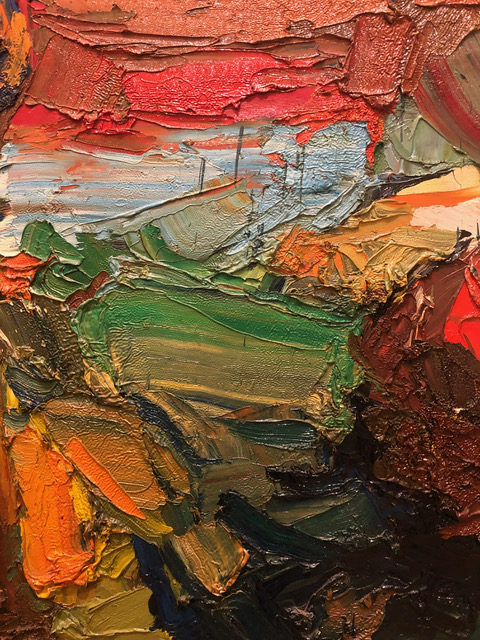
Unknown, Crocker Art Museum, Sacramento
“Whatever anthroposophy brings forth must be built on a solid foundation of enthusiasm . . .” ***
It is interesting that our group in Fair Oaks has constellated itself more in an artistic configuration than a scholarly one, for the most part. We embrace salons; we spend a lot of time on art, but not so much time on footnoting. The scientific exactitude of literary studies mines the depths to discover valuable ore. The smelters stand ready. The chimneys belch. The King of Metals watches with no small concern. He wonders: what will they do with the bounty of my kingdom? Novalis watches, too. He was a miner. He did his fair share of nitty gritty in the mines of German philosophy. He worked as hard as he could at the sciences of his time — natural, civil, legal, etc. He added to this enterprise: poetry and magical idealism. By doing so, he acted a bit like the serpent in Goethe’s tale — the green snake who shows up to set things aquiver. But — once in motion — who knows what sort of commotion will commence? (*** Rudolf Steiner, Awakening to Community, Lecture 1.)
Bad fortune, Good fortune;
Good fortune, Bad –
Each to its Opposite.
The Time is at Hand!— From The Fairy Tale, translation in revision, © Bruce Donehower, 2021
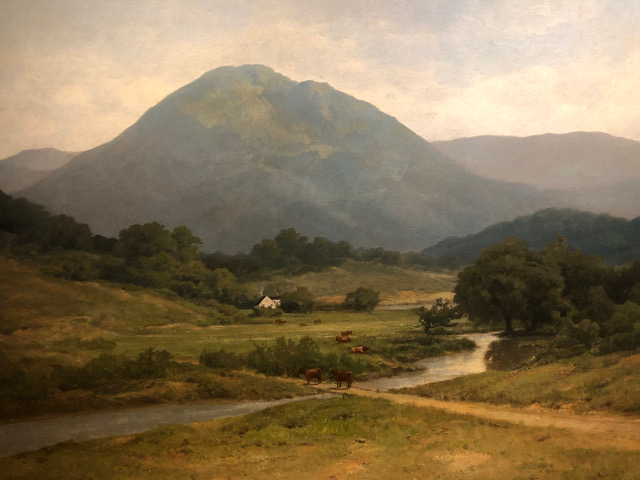
Unknown, landscape in Marin, CA, Crocker Art Museum, Sacramento
“The realm of beautiful appearance holds sway . . . “
I feel obliged to mention Schiller’s Aesthetic Letters. The snippet of a quote used as this paragraph header is from Letter 27, the capstone to the enterprise. Here, in a Johannine “shining city on the hill” moment, Schiller describes what might be translated as the “aesthetic state” — “state” here meaning “country,” not state of mind — although in truth, the two have much to do with one another, as Schiller explained. We began the year with this focus on the Letters, and some of us purchased the book eagerly and read it. But Goethe has been shouldering Schiller aside in recent meetings, and that’s not conducive to friendship, is it? I think the pals are OK, but we need to give consideration to the Letters. To help that along, I created an outline synopsis of this most exciting and lively text. As our meetings roll along, I’m sure we’ll find time at hand to discuss this important and vital contribution to German aesthetic theory and idealist philosophy. I’ll watch the calendar for a chance. But meanwhile, the left hand path!
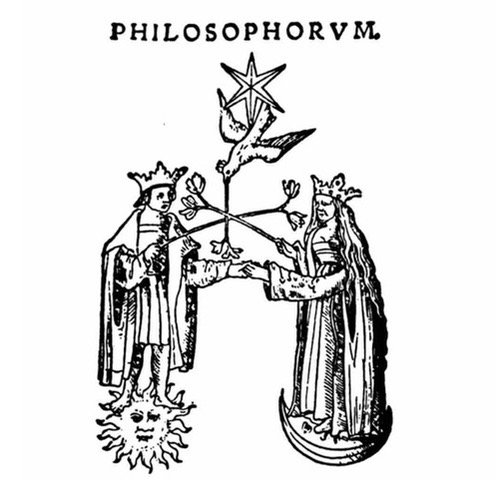
And speaking of Idealism . . . we should also give some attention to Fichte, who is never quite as absent as one might suspect, most especially when one takes the path to Jena. (Fichte was, as we know, so to speak, a member of the Hardenberg extended family and he spent time at the castle Siebeneichen. Fichte was discovered and fostered by the owner of Siebeneichen, a Hardenberg relative — and Friedrich’s father later took over the sponsorship.)
“. . . life is love and the entire form and force of life consists in love and arises from love. – What I have just said expresses one of the deepest principles of knowledge . . .”
— J. G. Fichte, The Way to the Blessed Life
I hope our group will have time in the future somewhere / somehow to explore the ways in which Goethe and Fichte assume such significance for Rudolf Steiner during the critical formative years of his intellectual adventures prior to 1900. (And let’s not forget Schelling!) That being said, Goethe’s Fairy Tale may help to keep us mindful of that most important word: metamorphosis. As Goethe liked to remind us: “Die and Become.”
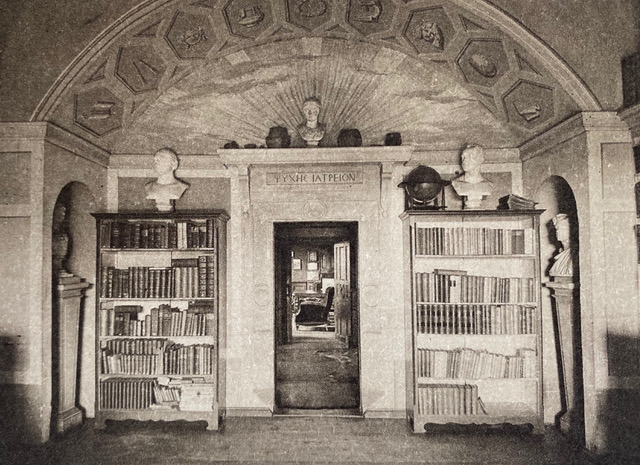
Library at Schloss Siebeneichen. Greek Inscription on Lintel: “Psyche Clinic.” Wow. Imagine Novalis, here
“Friends, the soil is poor. We must scatter abundant seed to assure even a middling harvest.”
— Novalis, Blüthenstaub
“Do I contradict myself?
Very well, then I contradict myself,
(I am large, I contain multitudes.)”
–Walt Whitman, Song of Myself“Associate with the smallest number of people.”
— Goethe, Legacy

